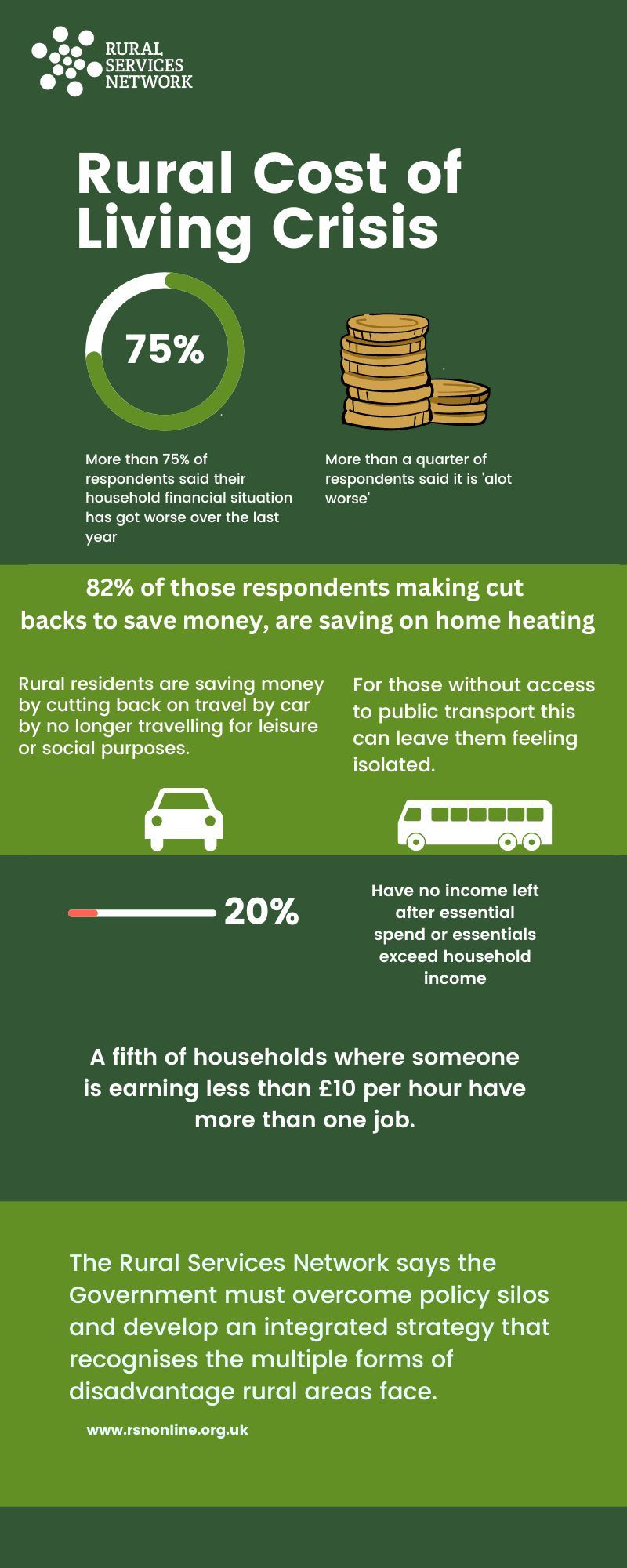T: 01822 851370 E: [email protected]
Visit RSN Survey about life in rural England to find out more.
Rural Housing Crisis Deepens Amidst Rising Cost of Living

RURAL HOUSING CRISIS DEEPENS AMIDST RISING COST OF LIVING: A DEEP DIVE INTO THE 2023 RURAL COST OF LIVING SURVEY
The below article was written by David Barrowcliff from English Rural Housing Association
The Rural Services Network and Citizens Advice – Rural Issues Group recently unveiled their comprehensive “Rural Cost of Living Survey 2023: Final Report“. This survey provides a detailed examination of the financial challenges faced by rural residents in the face of an unusually high cost of living increase. This blog post will delve deeper into the survey’s findings, with a particular emphasis on the rural housing issues that have been highlighted.
The Survey: A Broad Spectrum of Rural Households
The survey, conducted in early 2023, garnered responses from 6,780 rural residents. The respondents represented a broad spectrum of rural households, with 23% of them living in households whose income lies within the bottom quartile nationally. Interestingly, 18% of the respondents were from households where someone earns at or near the national minimum wage. This broad representation provides a comprehensive view of the financial challenges faced by rural households across different income levels.
Housing Affordability: A Growing Concern
One of the most striking findings of the survey relates to housing affordability. A significant 56% of respondents live in households which own their home outright. This might initially seem like a positive statistic, suggesting a high level of homeownership in rural areas. However, the reality is more complex and less rosy.
For many rural residents, the cost of mortgage or rent is a substantial burden. 20% of responses indicated that housing costs consume between 30% and 50% of their net or take-home income. A further 4% reported that housing costs take up more than 50% of their net income. These figures are alarming, as they suggest that a significant proportion of rural households are spending a large chunk of their income on housing, leaving little for other essential expenses.
The Asset-Rich, Income-Poor Paradox: A Unique Challenge
The survey revealed a paradoxical situation among households that include someone aged 65 or over. These households are the most likely to be low income (falling within the bottom quartile), yet two-thirds of these households own their home outright, with no mortgage. This indicates a sizeable cohort of rural residents who can be described as asset-rich but income-poor.
This paradox presents a unique challenge. On one hand, these households have a valuable asset in the form of their home. On the other hand, their low income means they may struggle to meet their day-to-day living expenses. This situation is further complicated by the rising cost of living, which is likely to put additional financial pressure on these households.
The Impact of Rising Living Costs: A Worsening Situation
The survey paints a stark picture of the impact of rising living costs on rural households. More than three-quarters of respondents reported that their household’s financial situation has worsened over the last year. This is a significant increase, suggesting that the rising cost of living is having a profound impact on the financial wellbeing of rural households.
Four groups were identified as being particularly affected: those in low income (bottom quartile) households; those in housing association/local authority homes; those in privately rented homes; and those where someone up to age 17 lives. These groups are likely to be the most vulnerable to the rising cost of living, and the survey’s findings suggest that they are feeling the pinch more acutely.
Coping Strategies: Cutting Back on Essentials
In response to these financial pressures, rural households are cutting back their spending across the board. This is especially true for low income (bottom quartile) households. Notable examples include reduced spending on visits to hospitality venues (91% of such households), home heating (90%), visits to entertainment venues (88%) and clothing or footwear purchases (87%).
These coping strategies reveal the extent to which rural households are struggling to make ends meet. The fact that many are cutting back on home heating, a basic necessity, is particularly concerning. This could have serious implications for the health and wellbeing of rural residents, especially during the colder months.
The Housing Crisis and Social Isolation
The survey also highlighted the social implications of the rural housing crisis. Many respondents reported that they were cutting back on non-essential journeys and making fewer visits to family or friends in an attempt to save on car running costs. This is a significant issue in rural areas, where public transport options are often limited, and residents are more reliant on cars. The resulting social isolation could have serious implications for the mental health of rural residents.
Conclusion: The Urgent Need for Policy Interventions
The findings of the 2023 Rural Cost of Living Survey underscore the urgent need for policy interventions to address the rural housing crisis. The rising cost of living is exacerbating existing challenges, pushing many rural households into financial hardship. The impact of this crisis extends beyond financial difficulties, with potential implications for health, wellbeing, and social connectivity.
It’s clear that solutions must be found to ensure that rural living remains sustainable and affordable for all. This includes policy measures to increase the supply of affordable housing in rural areas, initiatives to support low-income households, and strategies to mitigate the impact of the rising cost of living.
The 2023 Rural Cost of Living Survey provides valuable insights into the challenges faced by rural households. It’s a call to action for policymakers, housing providers, and community leaders to work together to address the rural housing crisis and ensure a sustainable future for our rural communities.
-
The full English Rural Housing Association article can be found here
-
The full Rural Cost of Living Survey 2023: Final Report is available at this link




